White blonde hair represents the ultimate expression of platinum perfection – a stunning shade that’s captivated beauty enthusiasts worldwide. We’ve all witnessed the magnetic pull of this ethereal color that transforms ordinary locks into show-stopping statement pieces. From Hollywood red carpets to everyday street style this icy blonde hue commands attention and exudes confidence.
Achieving this coveted look isn’t just about bleaching your hair to oblivion. We understand the science behind creating true white blonde tones while maintaining healthy vibrant strands. The process requires precision expertise and the right techniques to avoid common pitfalls that leave hair damaged or brassy.
Whether you’re considering your first platinum transformation or looking to perfect your current white blonde shade we’ll guide you through everything you need to know. From preparation and maintenance to styling tips that make your color pop – let’s explore how to master this iconic look safely and successfully.
What Is White Blonde Hair and Why Is It So Popular?
White blonde hair represents the lightest achievable shade on the color spectrum, featuring virtually no underlying pigment for a crisp, icy appearance. This platinum transformation has become increasingly popular as more people seek dramatic hair color changes that make bold fashion statements.
Understanding the Color Spectrum
White blonde sits at the extreme end of the blonde spectrum, requiring hair to be lightened to a level 10 or higher. Traditional blonde shades contain warm undertones like gold or honey, while white blonde eliminates these completely. Achieving this shade means removing nearly all natural melanin from the hair shaft through intensive bleaching processes.
The color appears different under various lighting conditions, shifting from bright white in natural sunlight to subtle silver tones under artificial lighting. Professional colorists measure this shade using the International Color Chart system, where white blonde registers as the palest possible blonde classification. Understanding these technical aspects helps us appreciate why this shade requires such precise application methods.
Celebrity Influence on the Trend
Celebrities have transformed white blonde hair into a coveted beauty trend through their high profile appearances. Stars like Kim Kardashian, Gwen Stefani, and Lady Gaga have showcased stunning white blonde transformations that sparked global interest in the shade. Their red carpet appearances demonstrate how this dramatic color change can completely reinvent someone’s image.
Social media amplifies celebrity hair transformations, with white blonde makeovers generating millions of views and shares across platforms. Fashion magazines feature these celebrity looks extensively, positioning white blonde as a symbol of boldness and sophistication. The trend has evolved beyond entertainment figures to include influencers and fashion icons who showcase various styling approaches for this striking hair color.
Essential Prerequisites Before Going White Blonde
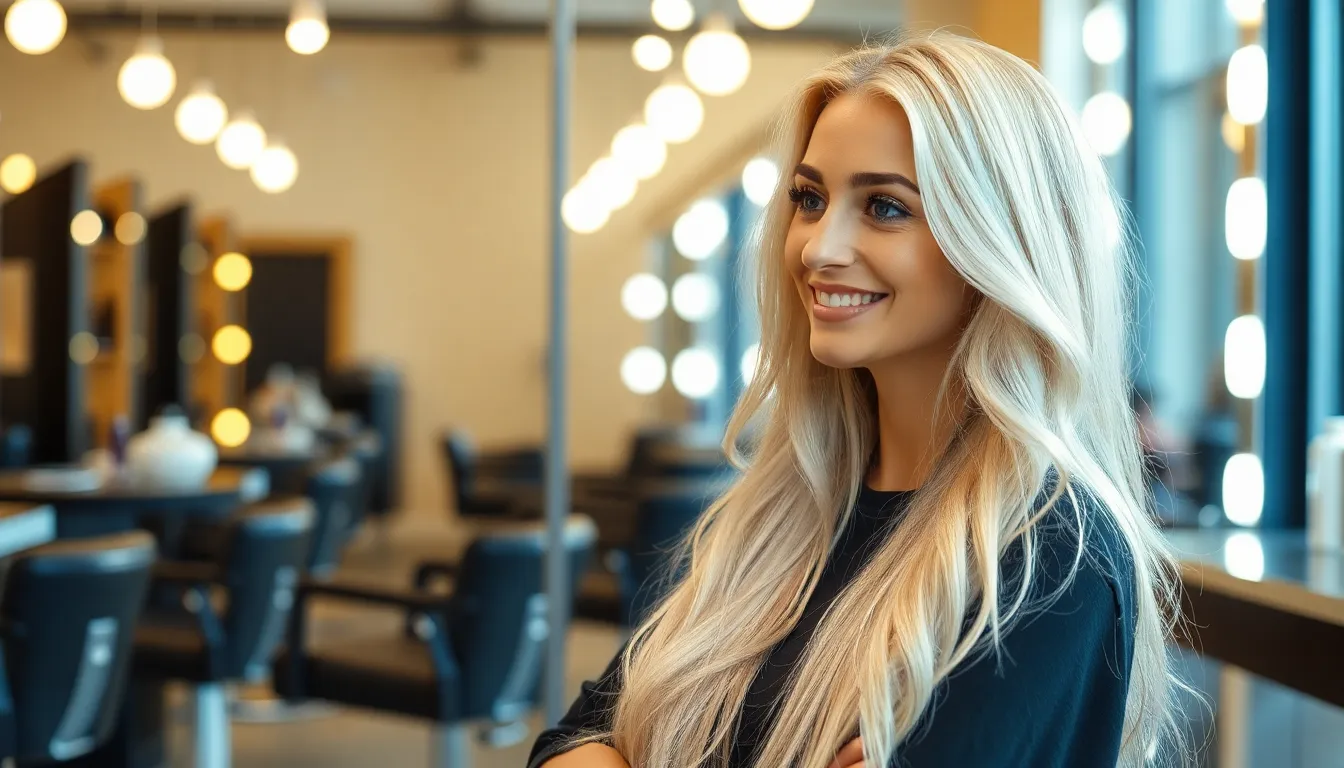
Transforming your hair to white blonde requires careful preparation and realistic planning. We’ve outlined the essential steps you need to take before beginning this dramatic color journey.
Hair Health Assessment
Evaluate your current hair condition before attempting any bleaching process. Damaged hair with existing breakage, excessive dryness, or chemical processing from recent perms or relaxers won’t withstand the intensive lightening required for white blonde. We recommend conducting a strand test 48 hours before your appointment to check for allergic reactions and assess how your hair responds to bleach.
Check your natural hair color level as this determines the complexity of your transformation. Dark brunette hair requires multiple bleaching sessions compared to naturally light brown or blonde hair. Virgin hair that hasn’t been chemically treated responds better to bleaching than previously colored hair.
Consider your scalp sensitivity since the bleaching process can cause irritation. If you have a sensitive scalp, psoriasis, or recent cuts, postpone your white blonde transformation until these issues resolve. Professional colorists often apply scalp protectant products to minimize discomfort during the process.
Realistic Timeline Expectations
Plan for multiple salon visits as achieving white blonde safely takes time. Most transformations require 2-4 sessions spaced 2-3 weeks apart to prevent severe damage. Dark hair may need 6-8 weeks to reach the desired level 10 lightness required for white blonde.
Expect touch up appointments every 4-6 weeks to maintain your white blonde color. Root growth becomes highly visible against the stark white backdrop, requiring regular maintenance sessions. We suggest scheduling these appointments in advance to maintain consistent color.
Allow recovery time between sessions for your hair to restore moisture and strength. Professional stylists recommend deep conditioning treatments and protein masks during this waiting period. Rushing the process leads to breakage, uneven color, and potential hair loss.
Budget Considerations
| Service | Price Range | Frequency |
|---|---|---|
| Initial transformation | $200-$600 | One time |
| Touch up sessions | $100-$300 | Every 4-6 weeks |
| Professional treatments | $50-$150 | Weekly/Bi-weekly |
| At-home maintenance products | $80-$200 | Monthly |
Invest in high quality products specifically designed for bleached hair. Purple shampoos, deep conditioning masks, and protein treatments become essential for maintaining white blonde hair health. Cheap products often contain harsh ingredients that fade your color or cause additional damage.
Factor in professional maintenance costs as white blonde requires more frequent salon visits than other hair colors. Emergency appointments for toning or color correction can add unexpected expenses to your budget. We recommend setting aside $150-$400 monthly for proper white blonde maintenance.
Consider the long term financial commitment since white blonde isn’t a temporary change. Returning to your natural color or switching to another shade often requires additional chemical processing and professional correction, which can cost $300-$800 depending on the complexity.
Professional vs. DIY: Choosing Your Transformation Path
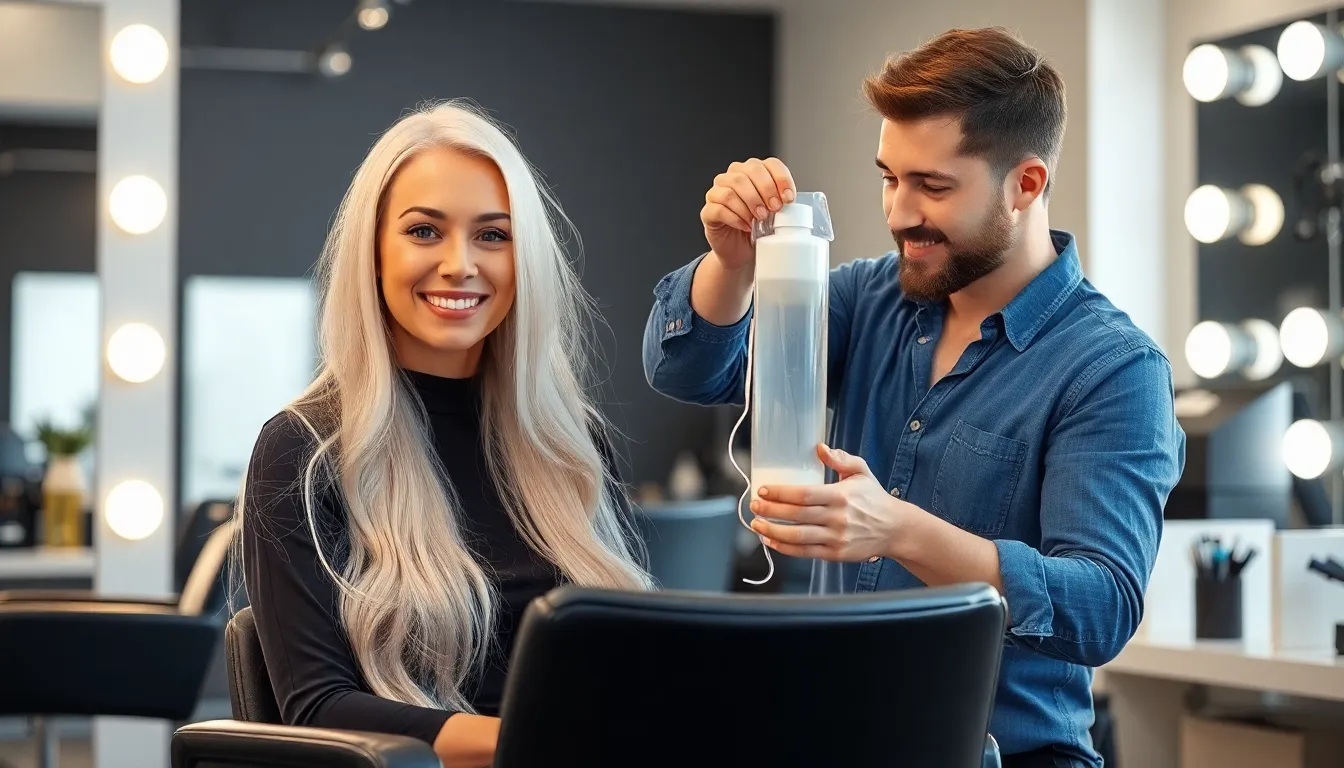
Deciding between professional salon services and DIY methods represents a crucial crossroads in your white blonde journey. We’ll examine both approaches to help you make an well-informed choice that aligns with your hair goals and circumstances.
Benefits of Professional Colorists
Professional colorists bring specialized expertise that’s essential for achieving authentic white blonde results. Their training includes understanding hair structure, chemical interactions, and advanced bleaching techniques that protect your hair’s integrity during the transformation process.
Customized formulations represent a major advantage of salon treatments. Colorists assess your natural hair level and condition to create personalized bleach mixtures that minimize damage while maximizing lightening power. They can adjust peroxide volumes and processing times based on your hair’s unique response patterns.
Professional equipment delivers superior results compared to consumer grade products. Salon tools include high quality heat lamps, professional mixing bowls, and precise application brushes that ensure even coverage and optimal processing conditions throughout your hair.
Advanced damage prevention techniques set professionals apart from DIY approaches. Colorists use bond builders like Olaplex during the bleaching process and apply protective treatments between sessions to maintain hair strength and elasticity.
Troubleshooting capabilities prove invaluable when complications arise. Experienced colorists can identify and correct issues like uneven toning, excessive brassiness, or unexpected color results that might leave DIY enthusiasts with damaged or unsatisfactory outcomes.
At-Home Kit Limitations
At-home bleaching kits contain lower peroxide concentrations that often can’t achieve the level 10+ lightness required for true white blonde results. Most drugstore products max out at 20 volume developer, which typically lightens hair only 2-3 levels per session.
Application challenges create important barriers for DIY transformations. Reaching all sections of your hair evenly becomes nearly impossible without professional assistance, leading to patchy results and uneven color distribution that requires costly correction.
Timing precision proves difficult to master without professional experience. Over processing can cause severe breakage and chemical burns, while under processing leaves you with brassy yellow tones that resist further lightening attempts.
Product quality differences between retail and professional formulations impact your final results. Consumer kits often lack the sophisticated toners and bond protectors that salons use to achieve smooth, even white blonde finishes.
Safety concerns multiply with DIY bleaching due to the high chemical concentrations involved. Burns, allergic reactions, and extreme hair damage can occur without proper knowledge of application techniques and safety protocols.
Cost Comparison Analysis
Initial salon transformations typically range from $300 to $800 depending on your starting color and hair length. This investment includes multiple bleaching sessions, professional toning, and protective treatments that preserve hair health throughout the process.
| Service Type | Initial Cost | Touch-Up Frequency | Annual Maintenance |
|---|---|---|---|
| Professional Salon | $300-800 | Every 4-6 weeks | $1,200-2,400 |
| DIY Kits | $30-80 | Every 2-3 weeks | $400-800 |
| Professional Products (Home Use) | $150-300 | Every 4-5 weeks | $800-1,200 |
DIY kit expenses appear lower upfront but often require more frequent applications due to faster fading and less effective results. You’ll typically spend $30-80 per session on quality at-home products, plus additional costs for correction appointments if problems arise.
Hidden costs emerge with both approaches through specialized maintenance products. Purple shampoos, deep conditioning treatments, and bond repair masks add $100-200 to your monthly hair care budget regardless of your chosen transformation method.
Professional correction services become necessary when DIY attempts go wrong. These emergency appointments can cost $200-500 to fix uneven coloring, excessive damage, or unwanted tones that result from improper home application techniques.
Long term value calculations favor professional services even though higher upfront costs. Salon treatments typically last longer, require fewer touch ups, and maintain better hair condition, eventually providing more cost effective results over time.
Step-by-Step White Blonde Hair Transformation Process
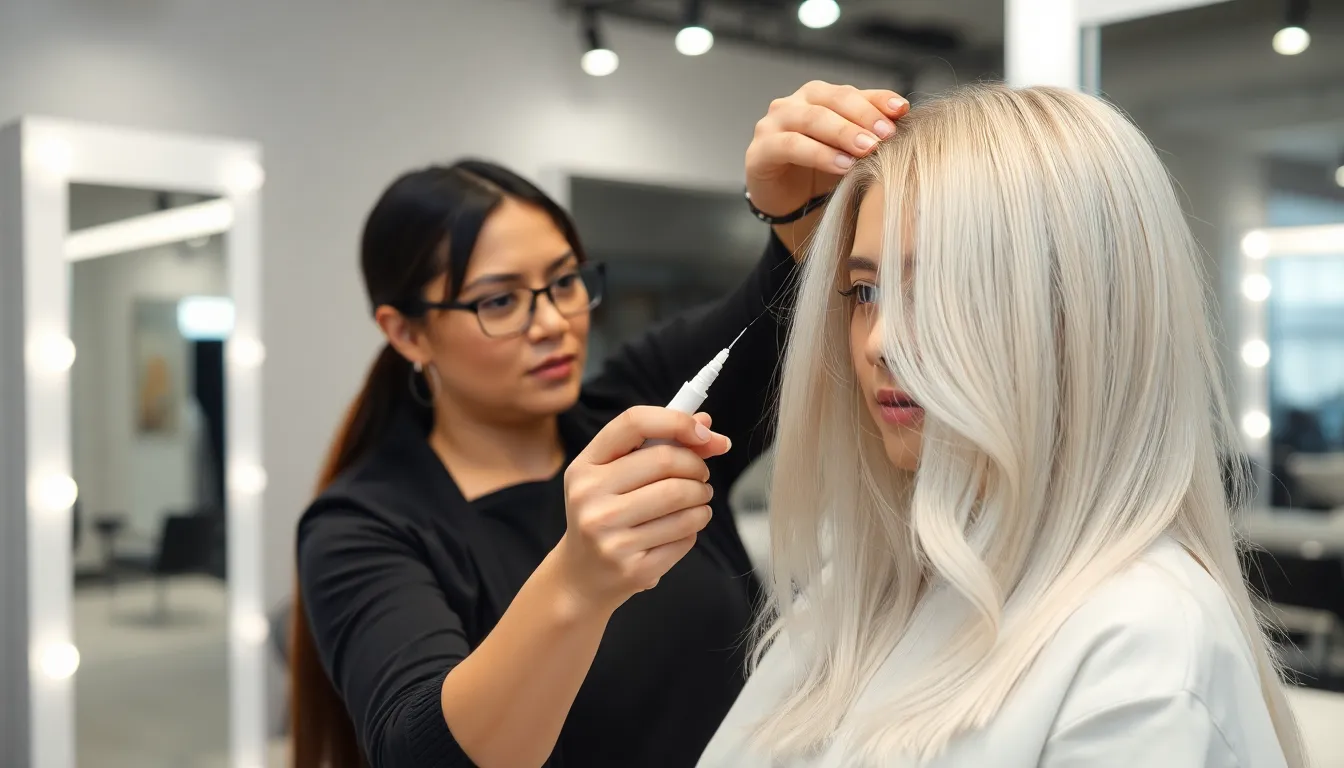
We break down the white blonde transformation into three critical phases that ensure optimal results while protecting your hair’s integrity.
Initial Consultation and Developer Levels
Professional colorists begin every white blonde transformation with a comprehensive hair analysis that determines your starting point and creates a personalized bleaching strategy. We examine your natural hair color level, previous chemical treatments, and overall hair condition during this essential first step.
Strand testing occurs before any full head application to predict how your hair will react to the bleaching process. Our stylists select a small section from the nape area and apply the intended bleaching formula to observe lift patterns and timing requirements.
Hair porosity assessment guides our choice of developer strength and processing methods. We test elasticity by gently stretching a wet strand to determine structural integrity before proceeding with intensive lightening treatments.
Previous color history reveals crucial information about existing pigments and potential obstacles during the bleaching process. Chemical residue from past treatments can create uneven lifting patterns that require specialized techniques to achieve consistent white blonde results.
Professional consultation includes timeline establishment and realistic expectation setting for your exact hair type. We discuss the number of sessions required, maintenance schedules, and potential challenges based on your hair’s current condition and desired outcome.
Bleaching Sessions and Developer Levels
Initial bleaching sessions typically use 20 volume developer for virgin hair or 30 volume for previously colored hair to achieve the necessary lift without excessive damage. We apply bleach systematically in small sections to ensure even saturation and consistent lightening throughout your entire head.
Multiple appointments become necessary when transforming darker base colors to white blonde, with most clients requiring 2-4 sessions spaced 2-3 weeks apart. Professional timing prevents over processing while allowing hair to recover between intensive bleaching treatments.
Developer strength progression may increase during subsequent sessions as we monitor your hair’s response and lifting capabilities. We often start conservatively and adjust formulations based on how your hair handles each bleaching round.
Processing time varies between 30-60 minutes depending on your natural pigment density and desired lift level. Our colorists check progress every 10-15 minutes to prevent over processing and ensure we achieve level 10 lightness required for true white blonde results.
Hair condition monitoring between sessions determines whether we can proceed with additional lightening or need to incorporate strengthening treatments. We assess elasticity, moisture levels, and structural integrity before scheduling follow up appointments.
Toning and Color Correction
Toner application immediately follows each bleaching session to neutralize unwanted yellow or brassy undertones that naturally occur during the lightening process. We use violet or blue based toners to counteract warm pigments and achieve the crisp, icy white blonde finish.
Color correction addresses any uneven lifting patterns or patchy areas that may develop during intensive bleaching treatments. Our stylists blend these inconsistencies using targeted toning techniques and sometimes additional spot bleaching in exact areas.
Gloss treatments enhance shine and seal the hair cuticle after toning to lock in your new white blonde color. We apply clear or slightly tinted glosses that add dimension while protecting your freshly lightened strands from environmental damage.
Custom toner formulations vary based on your skin tone and personal preferences for cool or neutral white blonde shades. Professional colorists mix precise ratios of toning products to achieve your desired undertone and color depth.
Final color assessment ensures we’ve achieved true white blonde results before you leave the salon. We examine your hair under different lighting conditions to confirm the color appears consistent and meets your expectations for the transformation.
Maintenance Requirements for White Blonde Hair
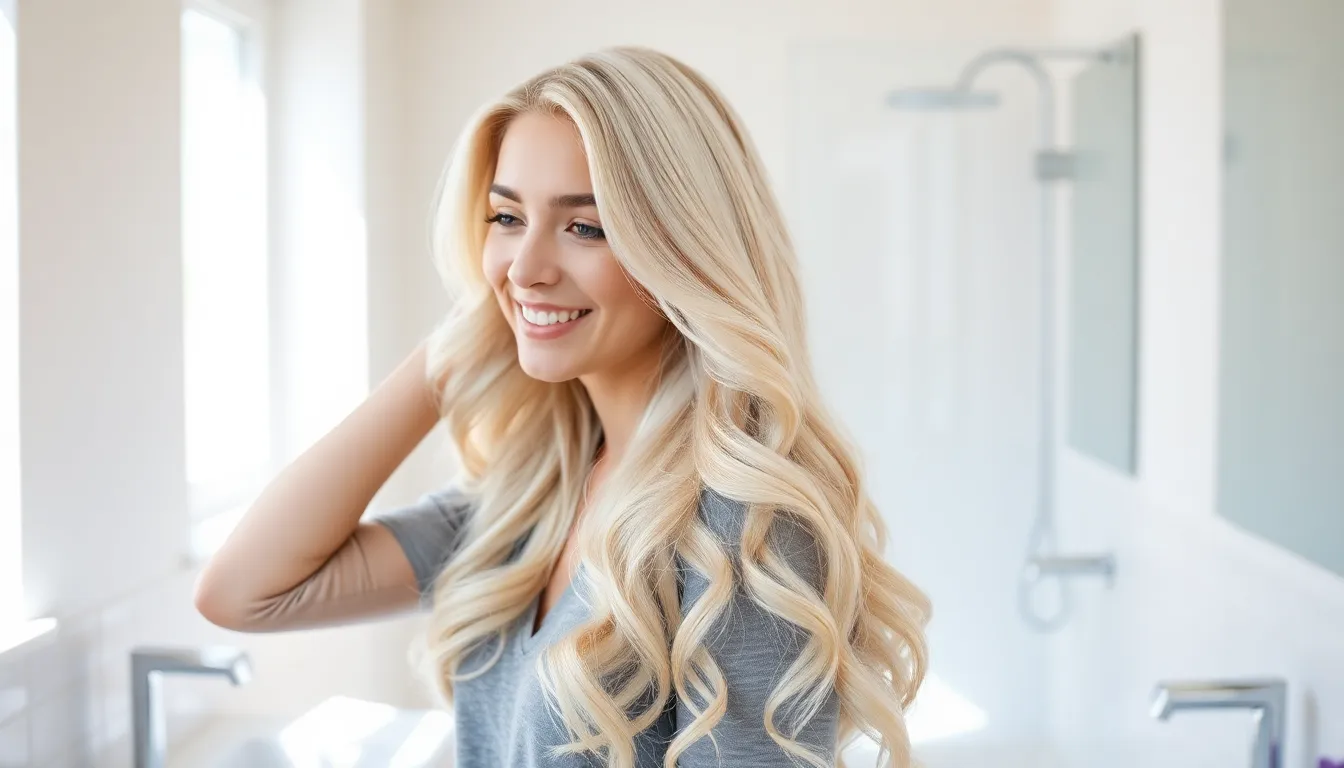
Maintaining white blonde hair demands consistent care to preserve its stunning appearance and hair health. We’ll outline the essential maintenance protocols that keep your platinum shade vibrant and your strands strong.
Weekly Toning Treatments
Apply toning treatments every 7-10 days to neutralize unwanted yellow or orange undertones. Professional toners containing violet or blue pigments work best for white blonde maintenance. We recommend using ammonia-free formulas that deposit color without causing additional damage to already processed hair.
Mix toners with low-volume developers (10-20 volume maximum) to prevent over-processing. Leave the treatment on for 5-15 minutes depending on your hair’s porosity and the intensity of unwanted tones. Check the color development every 3-5 minutes to avoid over-toning, which can result in an ashy or muddy appearance.
Consider alternating between different toning formulas based on your hair’s changing needs. Some weeks may require stronger violet-based toners to combat brassiness, while others might need gentler blue-based formulas for maintenance. Document which products work best for your exact hair type and lighting conditions.
Purple Shampoo Protocols
Use purple shampoo 2-3 times per week to maintain your white blonde color between salon visits. Apply the product to wet hair and massage gently into the scalp, allowing the pigments to work for 3-5 minutes before rinsing. We suggest starting with once weekly applications to gauge your hair’s response.
Rotate purple shampoo with hydrating formulas to prevent dryness and maintain moisture balance. Bleached hair requires extra hydration, so alternate between color-correcting and moisturizing shampoos. Look for products containing keratin, argan oil, or coconut derivatives that repair damaged cuticles.
Monitor your hair’s reaction to different purple shampoo concentrations and adjust accordingly. Some formulas contain higher pigment levels that work faster but may over-tone sensitive hair. Others offer gentler correction suitable for daily use. Keep notes about which brands and application times produce optimal results.
Regular Touch-Up Schedule
Schedule root touch-ups every 4-6 weeks to maintain seamless color coverage. New growth becomes visible within 3-4 weeks on most hair types, creating a stark contrast with white blonde lengths. Professional colorists can assess root development and determine the appropriate timeline for your exact growth rate.
Book full-length refresh treatments every 8-12 weeks to revitalize the entire hair shaft. These comprehensive sessions address color fading, tone correction, and overall hair health through deep conditioning treatments. We recommend planning these appointments in advance due to the time investment required.
Consider gloss treatments between major color appointments to enhance shine and seal the cuticle. Semi-permanent glosses add luminosity without altering the base color significantly. They typically last 4-6 weeks and help bridge the gap between full touch-up sessions while providing additional protection against environmental damage.
Essential Products for White Blonde Hair Care
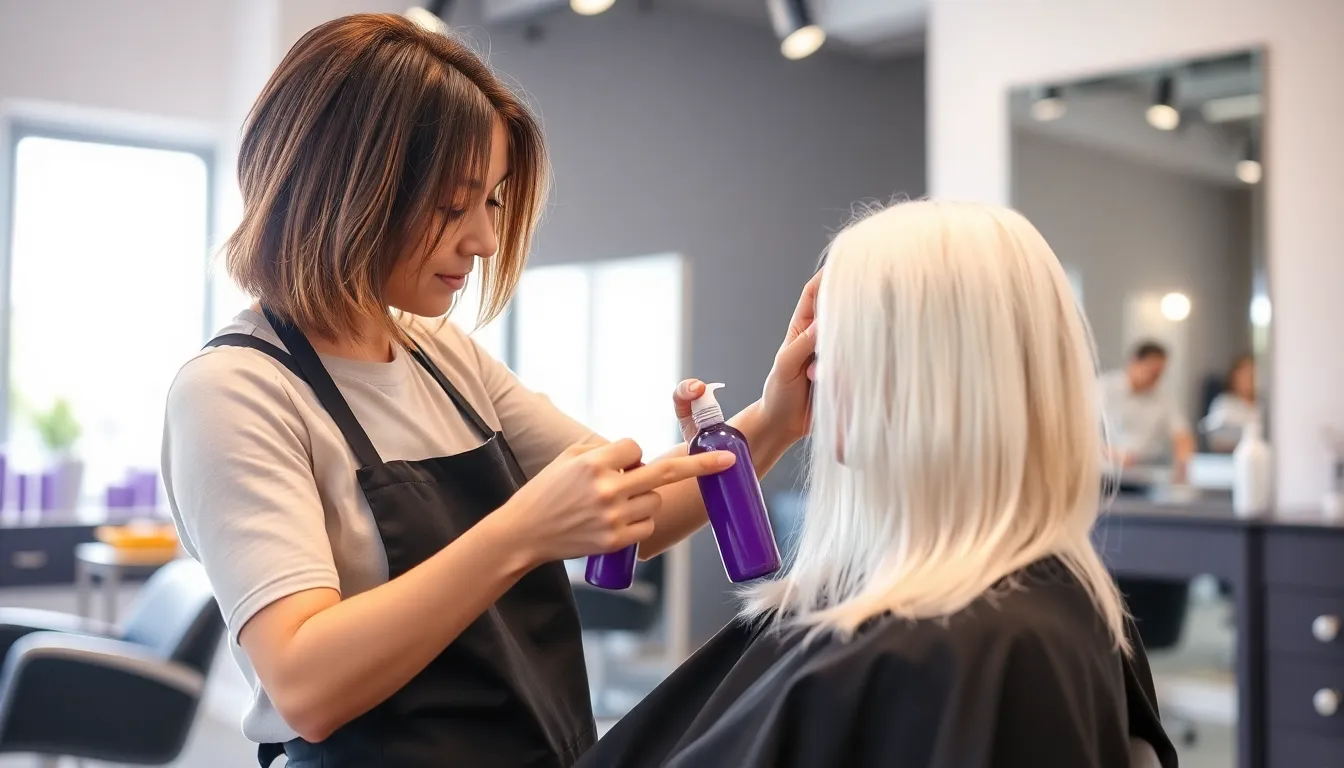
Maintaining white blonde hair requires specialized products formulated specifically for heavily bleached strands. We’ll guide you through the most effective product categories that protect your investment and preserve that stunning platinum shade.
Professional-Grade Shampoos and Conditioners
Purple shampoos serve as the foundation of white blonde maintenance routines. These sulfate-free formulas neutralize yellow undertones while cleansing without stripping essential moisture from fragile bleached hair. Products like Fanola No Yellow Shampoo and Joico Color Balance Purple Shampoo deliver immediate results with their concentrated violet pigments.
Moisturizing conditioners specifically designed for bleached hair become essential after each wash. We recommend selecting formulas enriched with keratin proteins and amino acids that rebuild damaged cuticles. Olaplex No. 5 Bond Maintenance Conditioner and Redken Extreme Conditioner provide deep hydration while strengthening compromised hair structure.
Color-depositing shampoos offer an alternative to traditional purple formulas for those seeking subtle tone adjustments. These gentle cleansers maintain platinum brightness between professional appointments. Brands like Matrix Total Results So Silver and Schwarzkopf Professional BC Bonacure Color Freeze deliver consistent results with regular use.
Weekly clarifying treatments remove product buildup and mineral deposits that can cause color dulling. We suggest alternating between purple and clarifying shampoos to maintain optimal color vibrancy. Choose formulas that remove impurities without compromising the hair’s natural protective barriers.
Heat Protectants and Styling Products
Thermal protection becomes critical when styling white blonde hair due to its increased porosity and fragility. Heat protectant sprays should be applied before every styling session to prevent protein loss and maintain elasticity. CHI 44 Iron Guard and TRESemmé Thermal Creations Heat Tamer offer broad spectrum protection up to 450°F.
Volumizing mousses designed for color-treated hair add body without weighing down fine blonde strands. These lightweight formulas typically contain UV filters that prevent color fading from sun exposure. Living Proof Full Thickening Mousse and Bumble and bumble Thickening Volume Mousse create lasting lift while protecting platinum tones.
Leave-in treatments provide ongoing protection throughout the day against environmental damage. We prefer multi-benefit formulas that combine heat protection with humidity resistance and color preservation. Redken Pillow Proof Blow Dry Express Primer and Matrix Biolage All-In-One Coconut Infusion Multi-Benefit Spray deliver comprehensive hair protection.
Finishing serums smooth cuticles and add shine to completed styles while sealing in moisture. These silicone-based products create a protective barrier against pollution and humidity. Moroccanoil Treatment Light and Kérastase Elixir Ultime create glossy finishes without greasy residue.
Deep Conditioning Treatments
Weekly protein masks restore strength to over-processed white blonde hair by filling in damaged areas along the hair shaft. These intensive treatments should contain hydrolyzed proteins that penetrate deeply into the cortex. Olaplex No. 3 Hair Perfector and K18 Peptide Prep Pro Mask rebuild molecular bonds broken during the bleaching process.
Moisture-intensive treatments balance protein therapies by restoring hydration to dry bleached strands. We recommend alternating between protein and moisture masks based on your hair’s current condition. Redken Extreme Mega Mask and Joico Moisture Recovery Treatment Balm provide long-lasting hydration for severely damaged hair.
Overnight treatments offer extended conditioning benefits for extremely compromised white blonde hair. These leave-in masks work while you sleep to repair damage and prevent breakage. Briogeo Don’t Despair Repair Deep Conditioning Mask and Aussie 3 Minute Miracle Reconstructor deliver salon-quality results at home.
Professional salon treatments like Olaplex or Brazilian Blowout services provide intensive repair that home products cannot match. Schedule these treatments monthly to maintain hair integrity and extend the life of your white blonde color. These services typically cost $75-150 but significantly improve hair health and manageability.
Common Mistakes to Avoid With White Blonde Hair
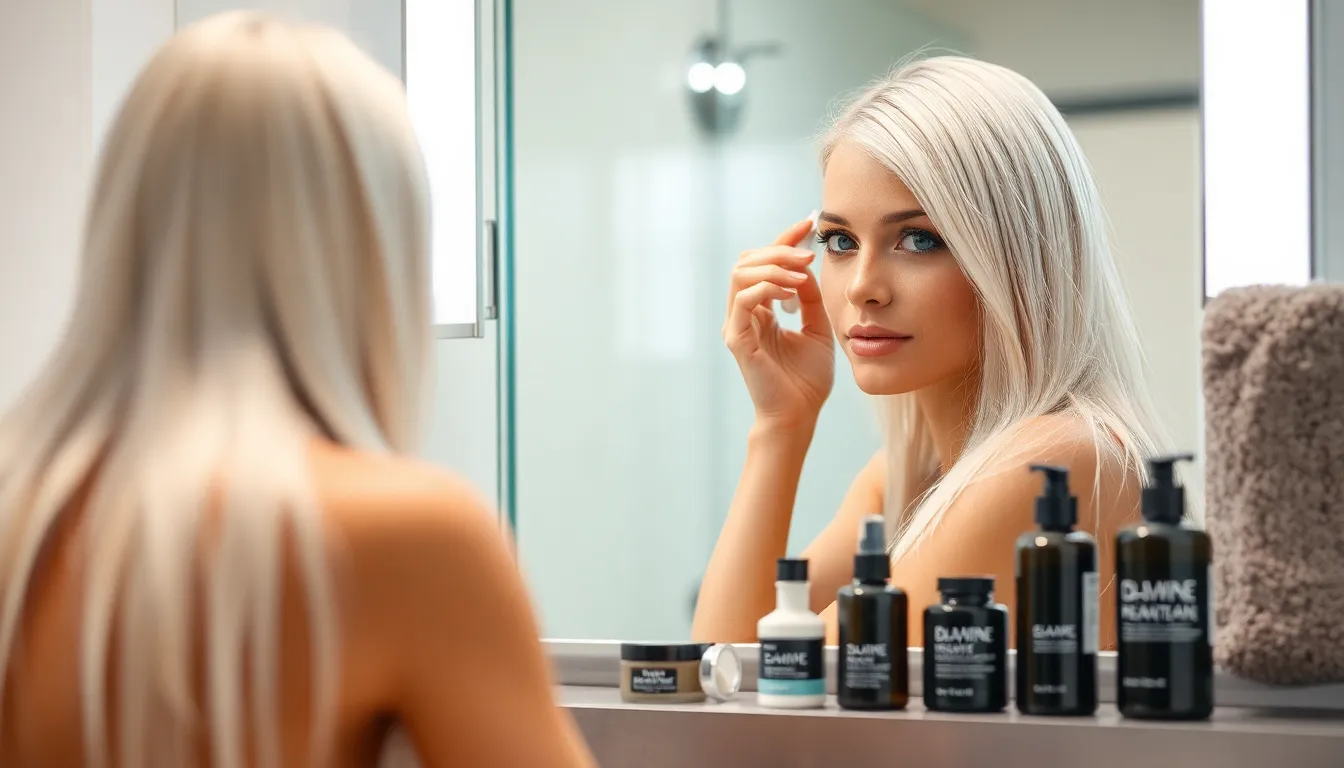
Achieving and maintaining white blonde hair requires careful attention to technique and ongoing care. We’ve identified the most critical mistakes that can derail your platinum transformation and compromise your hair’s health.
Over-Processing and Damage Prevention
Rushing the bleaching process leads to severe hair damage and breakage that can take months to repair. We recommend spacing bleaching sessions 2-3 weeks apart to allow your hair cuticles to recover and strengthen between treatments.
Applying bleach to previously processed sections causes over-lightening and creates weak spots that snap easily during styling. Professional colorists use sectioning techniques to target only new growth during touch-up appointments every 4-6 weeks.
Using developer strength that’s too high burns the hair shaft and scalp, resulting in chemical damage that’s often irreversible. We suggest starting with 20-volume developer for most hair types, only escalating to 30-volume when absolutely necessary for stubborn pigment removal.
Skipping strand tests before full application can lead to unpredictable results and unexpected hair damage. Test a small section 24-48 hours before your appointment to assess how your hair responds to the bleaching formula.
Ignoring your hair’s porosity levels during the bleaching process creates uneven lifting and patchy color results. High-porosity hair processes faster and requires lower developer volumes, while low-porosity hair needs longer processing times with careful monitoring.
Incorrect Toning Techniques
Choosing the wrong toner shade creates muddy or off-color results that require additional correction treatments. We recommend using violet-based toners for yellow undertones and blue-based formulas for orange pigments that appear during the lightening process.
Leaving toner on too long can deposit excessive color that turns your white blonde into an unwanted gray or purple shade. Most professional toners require only 5-15 minutes of processing time, depending on your hair’s porosity and desired results.
Applying toner to insufficiently lightened hair fails to neutralize underlying pigments and creates brassy or yellow results. Your hair must reach level 10 or higher before toning to achieve true white blonde color.
Using box store toners on heavily bleached hair often produces harsh, unnatural results because drugstore formulas aren’t designed for platinum transformations. Professional salon toners contain gentler ingredients that work effectively on compromised hair.
Skipping the base color assessment before toning leads to color corrections that don’t address your hair’s exact undertones. We evaluate the exact pigments present in your bleached hair to select the most effective neutralizing formula.
Neglecting Hair Health
Washing white blonde hair daily strips essential oils and accelerates color fading while causing dryness and brittleness. We recommend washing 2-3 times per week maximum, using dry shampoo between washes to maintain freshness.
Using regular shampoos instead of color-safe formulas removes toner deposits and allows yellow undertones to resurface within days of your salon appointment. Purple shampoos specifically formulated for blonde hair maintain your color between professional treatments.
Skipping deep conditioning treatments leaves bleached hair vulnerable to breakage, split ends, and moisture loss. Weekly protein treatments restore strength, while moisturizing masks replenish hydration that bleaching removes from your hair shaft.
Heat styling without protection causes additional damage to already compromised hair and can alter your white blonde color. We always apply heat protectant products before using blow dryers, flat irons, or curling tools on bleached hair.
Sleeping on cotton pillowcases creates friction that damages fragile blonde hair and causes tangling. Silk or satin pillowcases reduce breakage and help maintain your style overnight while protecting your color investment.
Best White Blonde Hair Styles and Cuts

White blonde hair transforms dramatically with the right cut and styling approach. We’ll explore versatile options that enhance your platinum transformation while complementing different face shapes and personal styles.
Short White Blonde Looks
Pixie cuts showcase white blonde’s striking intensity through clean, geometric lines that emphasize facial features. We recommend incorporating subtle layers around the crown to add volume and movement, particularly for fine hair textures. The platinum shade creates natural dimension in shorter styles without requiring additional highlighting techniques.
Bob cuts deliver sophisticated elegance when paired with white blonde coloring, offering versatility for both sleek and tousled styling approaches. Chin-length bobs work exceptionally well with this shade because they frame the face while allowing the color’s brilliance to remain the focal point. We suggest adding gentle waves or texture spray to prevent the look from appearing too severe.
Lob styles bridge the gap between short and medium lengths, providing enough hair to experiment with different textures while maintaining manageable maintenance requirements. The longer length allows for more styling options, including beachy waves, straight sleek looks, or romantic curls that complement the cool undertones of white blonde.
Long White Blonde Variations
Straight cascading styles create stunning visual impact when executed with healthy, well-maintained white blonde hair that extends past the shoulders. We recommend incorporating subtle face framing layers to add movement and prevent the look from appearing flat or lifeless. Professional glossing treatments enhance shine and create that coveted mirror-like finish.
Beachy wave textures complement white blonde’s ethereal quality through soft, natural-looking waves that add dimension and visual interest. This styling approach works particularly well because it disguises any potential damage from the bleaching process while creating romantic, effortless movement. Sea salt sprays and texturizing products enhance this look without weighing down the hair.
Sleek straight looks require exceptional hair health to execute successfully with white blonde, as any damage becomes immediately visible in this high-impact style. We suggest using professional smoothing treatments and heat protectants to maintain the integrity of bleached strands while achieving that glass-like finish.
Textured and Layered Options
Shag cuts bring edgy sophistication to white blonde hair through strategic layering that creates natural volume and movement throughout the style. The choppy layers work synergistically with the platinum shade to create a rock-and-roll aesthetic that’s both modern and timeless. We recommend this cut for those seeking low-maintenance styling with maximum visual impact.
Feathered layers soften the intensity of white blonde while adding dimension through varied lengths that catch light differently throughout the hair. This classic technique works exceptionally well with the stark beauty of platinum because it creates gentle transitions that enhance the color’s natural brilliance. Face-framing pieces add flattering dimension around the hairline.
Asymmetrical cuts showcase white blonde’s boldness through unexpected angles and lengths that create artistic visual interest. These modern styles work particularly well with the dramatic nature of platinum coloring because they emphasize the hair’s groundbreaking power. We suggest consulting with experienced stylists who understand how to balance asymmetrical proportions with your facial features.
White Blonde Hair for Different Skin Tones

Selecting the right white blonde shade depends on your skin’s undertones to create the most flattering and harmonious look. We’ll explore how different undertones pair with various platinum hues to help you achieve your perfect white blonde transformation.
Cool Undertones and Platinum Shades
Cool undertones pair beautifully with icy platinum shades that enhance natural coloring. Your skin likely has cool undertones if you notice blue, pink, or purple hues beneath the surface, and silver jewelry complements your complexion better than gold.
True platinum white creates stunning contrast against cool undertones, offering the purest white blonde appearance possible. This shade eliminates all warm pigments to achieve an almost metallic finish that mirrors your skin’s natural coolness.
Ash blonde variations provide softer alternatives while maintaining cool tones throughout the hair. These shades incorporate subtle gray undertones that prevent harsh contrasts while still delivering that coveted white blonde effect.
Silver white blends offer sophisticated options for those wanting dimension within their platinum look. We recommend these shades for individuals with fair to medium cool toned skin who want to add depth without warmth.
Warm Undertones and Creamy Whites
Warm undertones benefit from creamy white blonde shades that incorporate subtle golden or peachy notes. Your skin displays warm undertones if you see yellow, golden, or olive hues beneath the surface, and gold jewelry enhances your natural glow.
Vanilla blonde tones create harmony between your warm skin and white blonde goals. These shades maintain the platinum appearance while incorporating just enough warmth to prevent stark contrasts that might wash out your complexion.
Butter blonde variations offer richer alternatives that still achieve white blonde status. We suggest these options for medium to deeper warm toned skin where pure platinum might appear too harsh or artificial.
Champagne white blends provide luxurious options that combine cool and warm elements seamlessly. These sophisticated shades work particularly well for warm undertoned individuals seeking versatility in their white blonde transformation.
Neutral Undertones and Versatile Options
Neutral undertones offer the most flexibility in white blonde shade selection since your skin balances both cool and warm elements. You likely have neutral undertones if you can wear both silver and gold jewelry equally well, and your skin doesn’t lean obviously toward pink or yellow.
Classic white blonde serves as the perfect starting point for neutral undertoned individuals. This balanced shade provides clean platinum results without favoring either cool or warm extremes, making it universally flattering.
Beige blonde alternatives incorporate subtle neutral tones that complement your balanced skin perfectly. We recommend these shades for those wanting white blonde with slight depth that won’t compete with your natural coloring.
Pearl white options offer luminous finishes that shift between cool and warm depending on lighting conditions. These ever-changing shades provide versatility while maintaining that coveted white blonde appearance you’re seeking.
Custom blend possibilities allow professional colorists to create unique formulas customized specifically to your neutral undertones. We suggest consulting with experienced professionals who can adjust ratios to achieve your ideal white blonde match.
Protecting White Blonde Hair From Environmental Damage
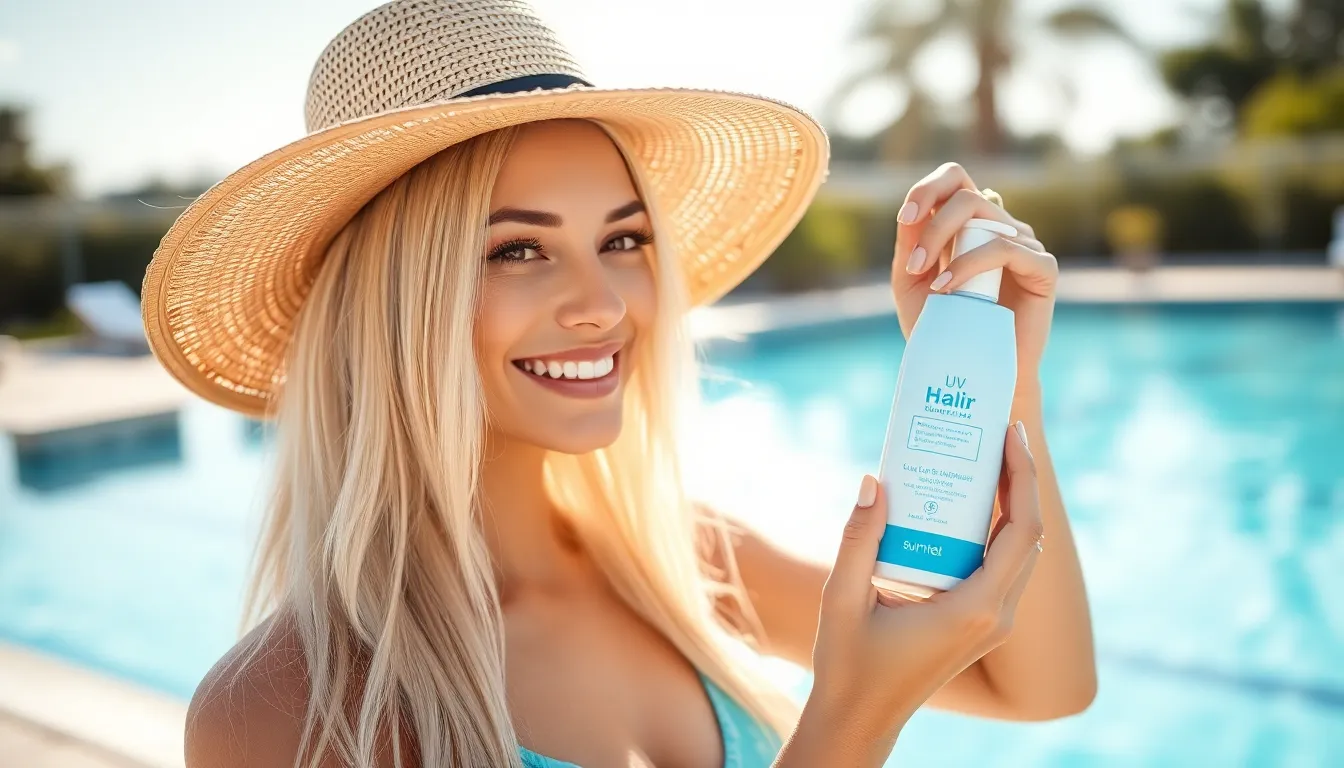
White blonde hair requires extra protection from environmental factors that can cause fading, discoloration, and structural damage. Environmental exposure poses unique challenges for platinum hair due to its delicate, highly processed nature.
Sun Protection Strategies
UV radiation breaks down the protein structure in bleached hair and accelerates color fading in white blonde shades. We recommend applying dedicated hair sunscreens with SPF 30 or higher before outdoor activities, focusing on the mid-lengths and ends where damage occurs most frequently. Wide-brimmed hats provide additional coverage for the scalp and hairline, while silk scarves offer a stylish alternative that protects against both UV rays and wind damage.
Professional UV-blocking sprays contain zinc oxide and titanium dioxide, creating an invisible barrier that reflects harmful rays away from the hair shaft. Reapplication every 2-3 hours ensures continuous protection during extended sun exposure. Swimming caps made from silicone materials prevent both UV damage and chemical absorption when spending time at pools or beaches.
Chlorine and Hard Water Answers
Chlorine molecules attach to the porous structure of bleached hair, causing green or yellow discoloration that’s particularly noticeable on white blonde shades. Pre-wetting hair with clean water before swimming creates a protective barrier that reduces chlorine absorption by up to 70%. Specialized swimmer’s shampoos containing EDTA chelating agents remove chlorine buildup after pool exposure.
Hard water minerals like copper and iron create metallic deposits that alter white blonde tones over time. Installing a shower filter system removes these minerals before they contact the hair, preventing gradual color shifts and maintaining true platinum results. Clarifying treatments using vitamin C tablets or commercial metal-removing products eliminate existing mineral buildup every 2-3 weeks.
Leave-in protective treatments formulated with coconut oil and shea butter seal the hair cuticle before water exposure. Rinsing immediately after swimming and applying a neutralizing shampoo within 30 minutes prevents chemical damage from setting into the hair structure.
Heat Styling Precautions
High temperatures cause protein denaturation in bleached hair, leading to breakage and color fading in white blonde shades. We suggest using heat protectants containing silicones and ceramides before every styling session, applying them to damp hair for maximum absorption. Temperature settings should remain below 350°F for flat irons and 300°F for curling tools to prevent thermal damage.
Sectioning hair into smaller pieces allows for lower heat settings while achieving desired results, reducing overall heat exposure time. Professional ceramic and titanium tools distribute heat more evenly than standard metals, minimizing hot spots that cause localized damage. Air drying whenever possible eliminates heat exposure entirely while preserving the integrity of white blonde color.
Heat-free styling methods like braiding, twist-outs, and roller sets create texture and volume without compromising hair health. Alternating between heat styling and protective styles gives bleached hair recovery time between thermal treatments.
Conclusion
White blonde hair remains one of the most captivating transformations we can achieve but it demands dedication and proper care. We’ve covered everything from initial considerations to maintenance protocols that’ll keep your platinum locks looking stunning.
The journey to white blonde isn’t just about bleaching – it’s about understanding your hair’s needs and committing to a comprehensive care routine. We’ve shown you how professional guidance combined with the right products can make all the difference.
Remember that protecting your investment means consistent toning weekly purple shampoo treatments and environmental protection. With the knowledge we’ve shared you’re now equipped to embark on your white blonde transformation confidently and maintain those gorgeous results for months to come.
Frequently Asked Questions
What is white blonde hair and how is it different from other blonde shades?
White blonde hair represents the lightest achievable shade on the color spectrum, characterized by its crisp, icy appearance with minimal underlying pigment. Unlike other blonde shades, it requires lightening hair to level 10 or higher, effectively removing natural melanin through intensive bleaching. This platinum shade appears almost colorless and has a striking, cool-toned finish that sets it apart from warmer blonde variations.
How much does it cost to get white blonde hair professionally?
The cost of achieving white blonde hair professionally varies based on hair length, current color, and location. Initial transformation typically ranges from $200-$800, with ongoing maintenance appointments every 4-6 weeks costing $100-$300. Additional expenses include specialized hair care products ($50-$150 monthly) and potential corrective treatments. The total annual investment can reach $2,000-$4,000 for complete maintenance and care.
Can I achieve white blonde hair at home with DIY kits?
While DIY kits are available, achieving true white blonde at home is challenging and risky. At-home products often lack the necessary strength and precision for optimal results, potentially causing severe damage or uneven color. Professional colorists have expertise in hair structure, customized formulations, and damage prevention techniques that DIY methods cannot replicate, making salon visits the safer choice.
How long does the white blonde transformation process take?
The white blonde transformation typically requires multiple salon sessions spaced 2-4 weeks apart to prevent damage. Initial consultation and strand testing occur first, followed by 2-4 bleaching sessions depending on your starting color. Each session lasts 3-6 hours. The complete process can take 6-12 weeks from start to finish, requiring patience and commitment to achieve optimal results safely.
What skin tones work best with white blonde hair?
Cool undertones pair exceptionally well with icy platinum shades, creating a harmonious contrast. Warm undertones benefit from creamy whites with subtle golden or peachy notes to complement their natural coloring. Neutral undertones offer the most flexibility, allowing for various white blonde options. A professional colorist can customize the perfect shade based on your specific undertones and preferences.
How often do I need to maintain white blonde hair?
White blonde hair requires consistent maintenance every 4-6 weeks for root touch-ups and color refreshing. Weekly toning treatments help neutralize unwanted yellow undertones, while purple shampoo should be used 2-3 times per week. Deep conditioning treatments are recommended bi-weekly, and professional gloss treatments every 6-8 weeks help maintain shine and protect the hair’s integrity.
What are the biggest mistakes to avoid with white blonde hair?
Common mistakes include over-processing hair with excessive bleaching, using incorrect developer strengths, and skipping strand tests. Neglecting proper aftercare, using non-color-safe products, and washing too frequently can cause rapid color fading and damage. Heat styling without protection and attempting DIY touch-ups between salon visits often result in uneven color and compromised hair health.
What products are essential for maintaining white blonde hair?
Essential products include purple shampoo to neutralize yellow tones, moisturizing conditioners with keratin and amino acids, and color-depositing shampoos for subtle adjustments. Heat protectants are crucial for styling, while deep conditioning masks restore strength and hydration. Professional-grade products specifically formulated for bleached hair provide better results than drugstore alternatives and help maintain color vibrancy longer.
How can I protect my white blonde hair from environmental damage?
Protect white blonde hair by using UV-blocking sprays and wearing wide-brimmed hats in sunlight to prevent color fading. Before swimming, pre-wet hair and apply protective treatments to minimize chlorine damage. Use shower filters to combat hard water effects, and always apply heat protectants before styling. Limit exposure to harsh weather conditions and consider protective hairstyles when outdoors.
What hairstyles work best with white blonde hair?
White blonde hair looks stunning in various styles, from short pixie cuts and sleek bobs that showcase color intensity to longer cascading styles and beachy waves. Textured cuts like shags and asymmetrical styles create modern, edgy looks. The key is choosing cuts that complement your face shape while allowing the platinum color to be the focal point of your overall appearance.







